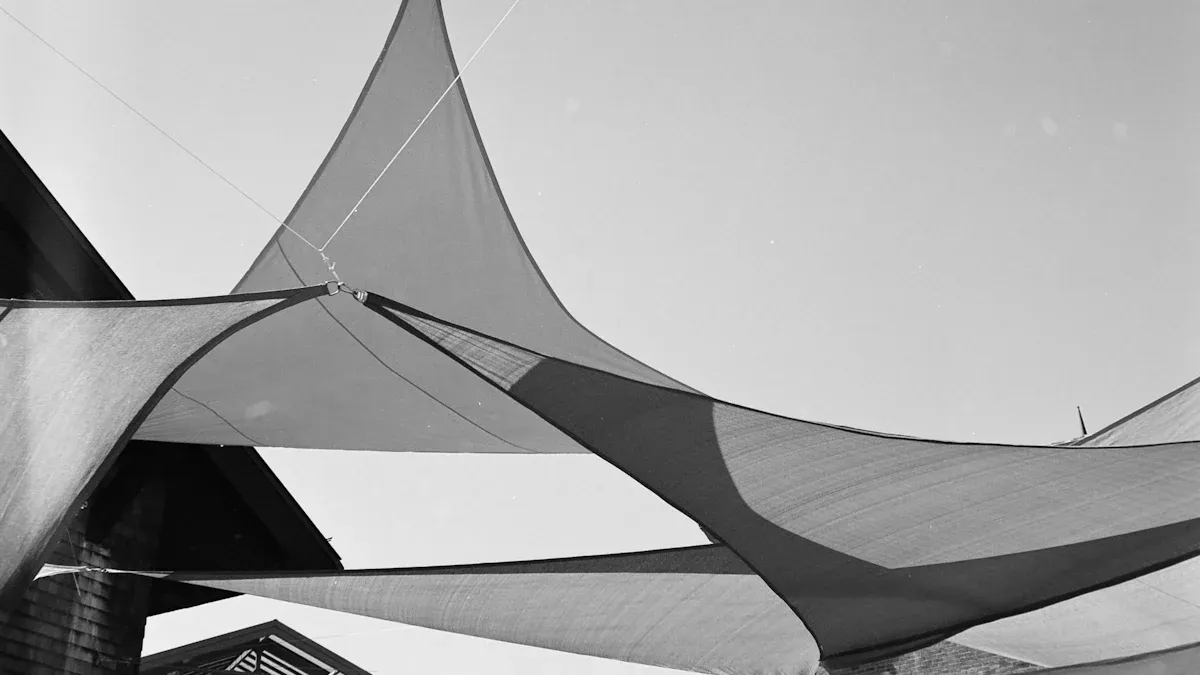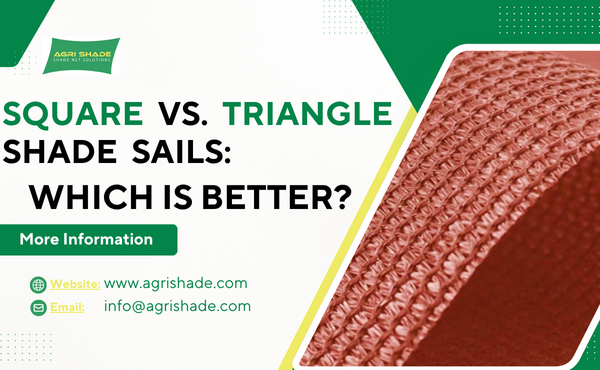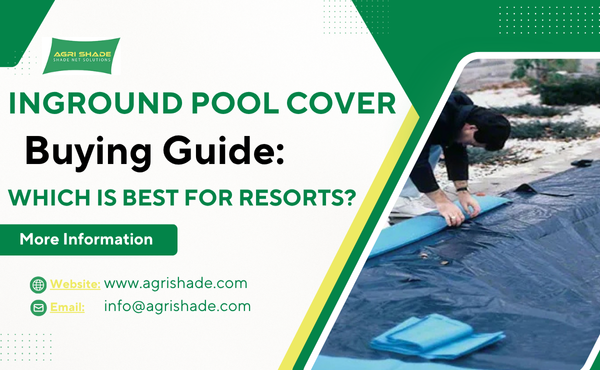Square Shade Sails often work best in large, open areas where people need maximum shade. Triangle shade sails suit smaller or oddly shaped spaces.
Each shape offers unique benefits. People should think about how much sun protection they need, the size and layout of their space, and the look they want to achieve. Choosing the right shape depends on coverage needs, installation options, and design preferences.
- Square shade sails cover wide areas.
- Triangle sails fit tight or irregular spots.
Square Shade Sails vs. Triangle Shade Sails
Shape Comparison
Square shade sails have a classic four-sided design. This shape creates straight lines and right angles. People often choose square shade sails for their symmetry and balanced look. The square shape allows for easy alignment with patios, decks, and other rectangular spaces. Triangle shade sails feature three sides and sharp corners.
Their design brings a modern touch to outdoor areas. Many homeowners use triangle shade sails to add visual interest or to fit spaces with unusual layouts.
The table below highlights the main differences between the two shapes:
| Feature | Square Shade Sails | Triangle Shade Sails |
|---|---|---|
| Number of Sides | 4 | 3 |
| Typical Appearance | Symmetrical, classic | Modern, dynamic |
| Best for | Large, regular spaces | Small, irregular spaces |
| Design Flexibility | High for straight layouts | High for layering and angles |
Coverage Differences
Square shade sails provide broad shade in one installation. Their four corners allow for secure attachment to posts, walls, or other structures.
People often use square shade sails to cover patios, pools, or outdoor kitchens. The large surface area blocks sunlight and creates a cool environment. Triangle shade sails offer flexible placement. Their three points fit into tight corners or odd-shaped areas. Some users layer multiple triangle shade sails to increase shade or create unique patterns.
- Square shade sails deliver maximum coverage in open spaces.
- Triangle shade sails adapt to spaces where square sails cannot fit.
People should consider the size and shape of their outdoor area before choosing. Square shade sails excel in wide, open zones. Triangle shade sails shine in compact or angled locations.
Shade Coverage and Sun Protection
Square Shade Sails for Large Areas
Square shade sails deliver a greater amount of sun protection in wide, open spaces. Their four-sided design allows people to cover patios, pools, and outdoor kitchens with fewer sails.
The large surface area blocks sunlight from above and creates a cool, shaded environment. Many homeowners choose square shade sails when they want effective sun protection for gatherings or outdoor activities.
People often install square shade sails over areas where families spend time together. The sails provide shade for tables, seating, and play zones. Square sails also work well for commercial spaces such as restaurants or parks. The broad coverage helps protect guests from harmful UV rays.
The table below shows how square shade sails compare to triangle shade sails in terms of coverage.
Triangle Shade Sails for Small Spaces
Triangle shade sails fit compact or irregular spaces where square sails cannot. Their three-point design allows people to install them in corners, narrow walkways, or angled patios. Triangle shade sails provide effective sun protection for small areas, such as balconies or garden nooks.
People often layer triangle shade sails to create creative patterns and increase shade.By overlapping sails, they can achieve more sun protection and cover unique layouts.
This flexibility makes triangle shade sails popular for spaces with obstacles or unusual shapes.Triangle shade sails also work well for temporary shade solutions. People can move or adjust them as needed. This makes them ideal for renters or anyone who wants flexible sun protection.
Installation Tips for Sails
Mounting Square Shade Sails
Square shade sails need four strong mounting points. People often use posts, walls, or sturdy beams for attachment. Each corner of the sail must connect to a secure anchor.
Stainless steel hardware, such as turnbuckles and pad eyes, helps keep the sail tight and stable.
Installers often use a “hypar” or hyperbolic layout for square sails. This method pulls two opposite corners higher than the other two. The result is a twist in the fabric that improves tension and helps rainwater run off. The hypar shape also adds a modern look to the shade sail.
Installing Triangle Shade Sails
Triangle shade sails offer more flexibility during installation. They only need three mounting points, which makes them easier to fit into tight or awkward spaces.
People can attach triangle sails to trees, fences, or building corners. This shape works well for layering multiple sails to cover larger or oddly shaped areas.
Installers often overlap triangle sails for extra shade or creative designs. Adjusting the height of each point can create interesting angles and improve water runoff. Triangle sails also require less hardware, which makes them a good choice for quick or temporary setups.
Read more for details:https://www.agrishade.com/product/sun-shade-sail-shade-solutions-for-every-space/
How to Choose Different Shade Sails
Visual Appeal
Square and triangle sun shade sail designs create different visual effects in outdoor spaces. Square sails give a neat and organized look. They suit patios, decks, and pool areas with straight edges. Many people choose square sails for a classic style. Triangle sails add a modern and dynamic touch. Their sharp angles and unique shapes stand out in gardens or courtyards. Some homeowners layer triangle sails to form creative patterns. This approach brings extra shade and a bold appearance.
The table below shows how each sun shade sail shape affects the look of an area:
| Sun Shade Sail Shape | Style Impact | Best For |
|---|---|---|
| Square | Classic, balanced | Large, regular spaces |
| Triangle | Modern, creative | Small, unique spaces |
Different Use Cases
Families use these sails to create cool zones for relaxing, eating, or playing. Triangle shade sails fit small yards, balconies, or garden corners. People layer triangle sails to add extra shade and style. Many choose triangle sails for spaces with trees or uneven layouts.
People select shade sails to block uv rays and protect furniture from fading. Square sails suit large gatherings and family events. Triangle sails work well for small seating areas or walkways. Both shapes help homeowners enjoy outdoor spaces longer during hot months.Businesses use shade sails to improve comfort and safety in outdoor spaces. Restaurants install square sails over dining patios to keep guests cool.
Parks and playgrounds use triangle sails for shaded seating and play zones. Schools add shade sails to protect students from uv exposure during recess.
Commercial properties often combine square and triangle sails for maximum shade. Shopping centers use sails to cover walkways and entrances. Event venues set up shade sails for outdoor gatherings and festivals. The sails help reduce heat and make outdoor spaces more inviting.
A list of common commercial uses for shade sails:
- Restaurant patios
- School playgrounds
- Park seating areas
- Shopping center walkways
- Event venues
Durability of Triangle Shade Sails
Wind Resistance
Triangle shade sails show impressive wind resistance because of their three-point design. Each corner anchors securely, which helps distribute tension evenly across the fabric. This structure reduces the risk of tearing or sagging during strong winds. Many installers recommend using reinforced mounting hardware for extra stability.
People often choose a triangular shade sail for areas that experience frequent gusts. The sail’s aerodynamic shape allows wind to flow around it, rather than pushing directly against a flat surface.
A comparison table below highlights wind resistance features:
| Feature | Triangle Shade Sails | Square Shade Sails |
|---|---|---|
| Anchor Points | 3 | 4 |
| Wind Flow | Excellent | Good |
| Risk of Sagging | Low | Moderate |
Long-Term Use
Triangle shade sails offer reliable performance over many seasons. Manufacturers use high-density polyethylene or similar materials to create sails that resist fading, mold, and UV rays. These fabrics provide long-lasting sun protection for outdoor spaces.
People often notice that triangle sails maintain their shape and color longer than some other options. Regular cleaning and inspection extend the lifespan of the sail.
A few steps help ensure durability:
- Clean the sail with mild soap and water.
- Inspect mounting hardware for rust or wear.
- Store the sail indoors during extreme weather.
Conclusion
Square shade sails provide broad coverage for large, open spaces. Triangle shade sails offer flexible solutions for small or irregular areas. People should review their outdoor space, sun protection needs, and design goals before choosing.
- Square sails suit patios and pools.
- Triangle sails fit corners and creative layouts.




















